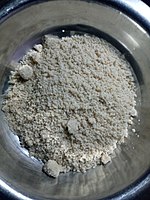Egusi
This article needs additional citations for verification. (July 2014) |


Egusi (Yoruba: ẹ̀gúsí, Igbo: ègwusi), also known as, agusi, ohue, Ikpan, Ikon, or agushi) // is the name for the protein-rich seeds of certain cucurbitaceous plants (squash, melon, gourd), which, after being dried and ground, are used as a major ingredient in West African cuisine.[1][2]
Authorities disagree whether the word is used more properly for the seeds of the colocynth, those of a particular large-seeded variety of the watermelon, or generically for those of any cucurbitaceous plant.[3] The characteristics and uses of all these seeds are broadly similar. Major egusi-growing nations include Nigeria, Burkina Faso, Togo, Ghana, Côte d'Ivoire, Benin, Mali, and Cameroon.[3]
Species from which egusi is derived include Cucumeropsis mannii and Citrullus lanatus.[4]
Usage
Egusi soup is a soup thickened with the seeds. Egusi soup is popular in West Africa, with considerable local variations.[5] Besides the seeds, water, and oil, egusi soup typically contains leaf vegetables, palm oil, other vegetables, seasonings, and meat,[6]. Leaf vegetables typically used for egusi soup include bitterleaf, pumpkin leaf, celosia and spinach. Typical other vegetables include tomatoes and okra. Typical seasonings include chili peppers, onions, and locust beans. Also commonly used are beef, goat, fish, shrimp, or crayfish.
In Nigeria, egusi is common among the people of the southeastern Igbo people, Efik, Ibibio and Annang people of southern Nigeria, and the southwestern part of Nigeria by the Yoruba people.[citation needed]
In Ghana, egusi is also called akatoa or agushi, and is used for soup and stew,[7] most popularly in palaver sauce.[8]
In the late 1980s, the Government of Canada funded a project intended to develop a machine to help Cameroonians shell egusi seeds.[9] A machine has also been developed in Nigeria to shell egusi.[10]
Gallery
-
A plate of pounded yam, and egusi soup
-
Pounded yam, and egusi soup served with fish
-
Egusi and bitter leaf soup
-
Egusi powder with powdered lemon
-
Egusi soup with ponmo and beef
-
Egusi soup with vegetables and dried catfish, prawns, beef and roasted cowskin
See also
- Egusi sauce
- Igbo cuisine
- List of African dishes
- List of melon dishes and foods
- List of stews
- Pumpkin seeds
- Watermelon seed oil
References
- ^ Rachel C. J. Massaquoi, "Groundnut, Egusi, Palm Oil, and Other Soups", in Foods of Sierra Leone and Other West African Countries: A Cookbook, AuthorHouse, 2011, p. 36.
- ^ Ukegbu, Kavachi Michelle (2021). The art of fufu : a guide to the culture and flavors of a West African tradition. Grubido. Austin, Texas. ISBN 978-1-62634-596-6. OCLC 1241244901.
{{cite book}}: CS1 maint: location missing publisher (link) - ^ a b National Research Council (2006). "Egusi". Lost Crops of Africa: Volume II: Vegetables. National Academies Press. pp. 158 (155–171).
- ^ Blench, Roger (2006). Archaeology, language, and the African past. Altamira Press. ISBN 9780759104655.
- ^ Badiru, I. & Badiru, D. (2013). Isi Cookbook: Collection of Easy Nigerian Recipes. Bloomington: iUniverse. p. 36. ISBN 9781475976717.
- ^ Okwanma, Robin. "Egusi Soup: Ingredients". CYBER NG. Robin Okwanma. Retrieved 22 November 2022.
- ^ "13 Nigerian Foods That Are Eaten By Ghanaians But Have Different Names" Archived 2016-11-27 at the Wayback Machine, OMGVoice.
- ^ Freda Muyambo, "Palaver Sauce Recipe", About food.
- ^ "Projects in Cameroon". Archived from the original on 2014-11-27.
- ^ Shittu, S. K. & Ndrika, V. I. O. (2012). "Development and performance tests of a melon (egusi) seed shelling machine". Agricultural Engineering International: CIGR Journal.







